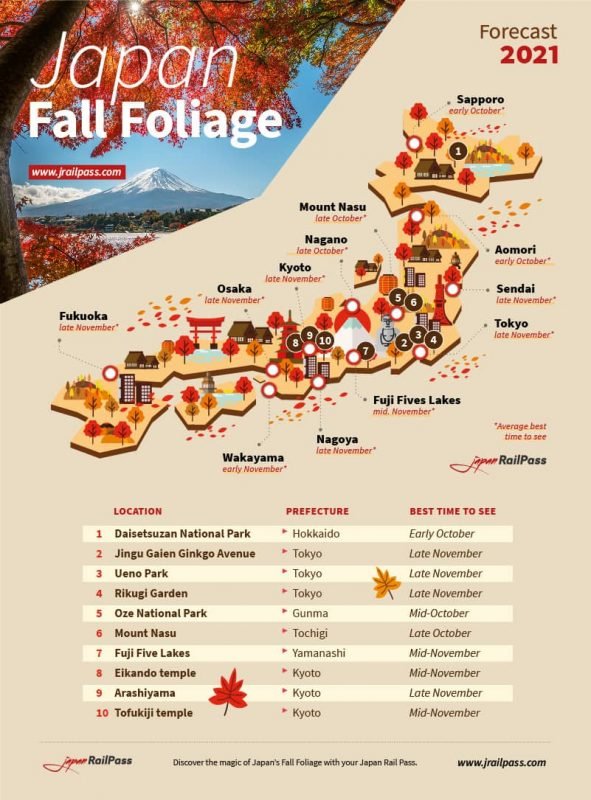Japan is famous for its four distinct and breathtaking seasons, and many visitors to the country often consider the Japanese autumn to be the most beautiful. As temperatures dip after the scorching summer, the colors of the leaves change into vibrant shades of orange, red, yellow, and brown. This fall foliage is a magnificent sight that has inspired artists and poets for centuries.

In Japan, the natural phenomenon is called koyo or momiji (meaning red leaves). The activity of searching for the most striking shades of leaf is known as Momijigari (red leaf hunting) It has been popular in Japan for centuries and is now a major draw for tourists.
Momijigari: Fall leaves viewing
Autumn in Japan is known as Aki (秋) and the fall foliage is classified by two different terms: Koyo (紅葉) and Momiji (紅葉).
Koyo describes foliage with red and yellow colors, while Momiji (紅葉) specifically applies to the intensely red maple leaves that are particularly spectacular during the season.
The maple leaf symbolizes fall in Japanese culture and its use is widespread.
Maple-shaped cakes are typical during the fall, and the leaves themselves are often eaten as tempura: a delicious, deep-fried, sweet snack. There are various varieties of maple leaf tempura served throughout the country during the season, often accompanied by a cup of Japanese tea.
The tradition of Momijigari (viewing of fall leaves) has had a profound influence on Japanese culture since the Heian period (794-1195), with hunting for maples particularly popular across the country.
For Buddhists, it’s a moment that is important both spiritually and symbolically as it reminds us that life is ephemeral. Momijigari also features heavily In eighth-century Manyoshu poetry as well as the classical Heian Period novel ‘The Tale of the Genji’.
There is no shortage of stunning places in Japan to enjoy the phenomenon, though the best days to see it vary from place to place and from year to year. Momijigari is often enjoyed in many different ways, including on hikes, picnics, drives, bike rides and camping trips.
Fall foliage forecast 2021
The turning of the leaves in Japan varies due to temperature, elevation, and latitude, and the best time to experience the phenomenon differs every year. In general, the autumn foliage season begins in mid-September on the island of Hokkaido, the northernmost island.
In other parts of Japan, like Tokyo and Kyoto, the best viewing times typically range from mid-October through early December. Peak viewing in each area typically lasts between two weeks to more than one month.
Therefore, while many regions peak in November, some areas can start changing as early as September or as late as December. When temperatures turn cold early, the Japanese fall colors appear sooner – up to several weeks early – and vice versa.

Where to see autumn leaves in Japan
Any region in Japan is really a good area for Koyo viewing in the autumn, and the best places to see autumn colors will largely depend on when you travel. If you are visiting a bustling city such as Tokyo, city parks offer thousands of trees for Koyo and Momji leaf hunting.
The country’s many mountainous hiking trails offer a great alternative option for those wishing to take in the Japanese countryside. The area surrounding Mount Fuji, including lake Kawaguchiko, and national parks such as Daisetsuzan in Hokkaido and Oze north of Tokyo are ideal for Momijigari.
Another option is simply looking out the window while traveling by train if visiting the country with a Japan Rail Pass. Between stations, you’ll have the opportunity to observe the local countryside in all its autumn glory.
For a truly unique Koyo experience at a relaxed pace, consider a sightseeing train ride on the Sagano Scenic Railway through the picaresque Arashiyama region.
Best places in Kyoto
Kyoto is often considered the best city in Japan to view the impressive fall foliage, thanks in part to the large number of traditional temples with sprawling, forested grounds.
Some of the best Momijigari spots in Kyoto include:
- Arashiyama – An extensive bamboo forest on the outskirts of the city
- Daigo-Ji Gardens – A large green space popular with photographers in the autumn
- Daitoku-Ji – A temple with an impressive tunnel made out of maples at the entrance.
- Eikando Temple – The trees in these temple grounds are impressively lit during the fall
- Kinkaku-Ji – The gold-leaf coating of this famous temple is perfectly complemented by the colours of its surrounding trees in the autumn
- Nanzen-Ji – Made famous by the film Lost in Translation, which shot scenes at this temple during the fall
- Tenryu-Ji – A UNESCO World Heritage Site with an impressive landscape garden
- Tofukuji Temple – The Tsutenkyo Bridge in the temple grounds is one of the most popular leaf viewing spots in the city.
Best places in Tokyo
Although internationally known as a bustling metropolis, Tokyo is also packed with green spaces such as parks and gardens ideal for Momijigari. Some of the most popular include:
- Jingu Gaien Ginkgo Avenue – A famous street lined with ginko trees which turn a bright yellow in the autumn
- Koishikawa Korakuen – A popular garden, close to the Tokyo Dome, which boasts a large number of maple trees
- Mount Takao – Located on the outskirts of the city, this busy weekend destination is ideal for an autumn hike
- Oze National Park – Another popular hiking spot, located around 100 kilometers to the north of the city
- Rikugien Garden – An impressive landscape garden popular for both red leaf and cherry blossom viewing
- Shinjuku Gyoen – A large city park popular for autumn picnics
- Ueno Park – This large green space boasts over 9,000 trees with spectacular colors in the fall
- Yoyogi Park – Located close to the trendy Harajuku neighborhood and offers a mix of both ginkos and maples with spectacular autumn colors.

